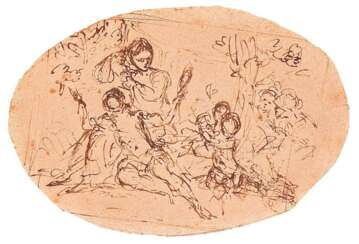sorceress

John Greenleaf Whittier was an American poet, essayist, and member of the American Anti-Slavery Society.
Whittier devoted 30 years of his life to the fight against slavery. Only after the Civil War, already at a mature age, he was finally able to engage in his favorite pastime - poetry. Past his fascination with Burns, Whittier became an eloquent advocate of justice, tolerance, and liberal humanism. He has been called "America's finest religious poet" for the high spiritual and moral values he extolled, and many of his poems are still sung as church hymns.
Whittier also wrote about the region's past, about life in New England before industrialization. In late nineteenth-century America, Whittier was second only to Henry Wadsworth Longfellow in popularity. His most famous poem, "Bound by Snow," was published in 1866. Whittier was also a longtime editor of the New England Weekly Review.


Nikolay Petrovich Bogdanov-Belsky (Russian: Николай Петрович Богданов-Бельский) was a renowned Russian artist, celebrated for his genre paintings depicting the education of peasant children, as well as portraits and impressionistic landscapes. Born in 1868 in Shitiki, Smolensk Governorate, Bogdanov-Belsky added "Belsky" to his surname from the district where he was born. His academic journey in art began at the Semyon Rachinsky fine art school, followed by studies at the Moscow School of Painting, Sculpture and Architecture, and later at the Imperial Academy of Arts in St. Petersburg.
Throughout his career, Bogdanov-Belsky was an active participant in Russian artistic circles, becoming a member of the Peredvizhniki from 1895 and the Arkhip Kuindzhi Society from 1909. His works often centered around the themes of rural education and childhood, capturing the subtle interplay of light and shadow and the innocence of his subjects. Notable works include "Mental Arithmetic, in the Rachinsky School" (1895) and "Sunday reading in a village school" (1895), which reflect his deep engagement with the theme of education.
After the Soviet Union came into power, the political climate and the disfavor towards realism compelled him to move to Riga, Latvia in 1921, where he continued his artistic endeavors until his death in Berlin in 1945 due to an Allied bombing during World War II.
For collectors and enthusiasts of Russian art, Bogdanov-Belsky's works offer a poignant glimpse into pre-Soviet Russian culture and education. His paintings are not only aesthetically pleasing but also historically significant, capturing the essence of a bygone era. To stay updated on sales and auction events featuring works by Nikolay Petrovich Bogdanov-Belsky, consider signing up for updates. This subscription will ensure you are informed about new opportunities to acquire pieces by this illustrious artist.


Edmund Spenser was an English poet of the Queen Elizabethan era.
Spenser studied Latin and Greek, as well as literature and religion, at Pembroke Hall, Cambridge University. In 1579 he published his first poetry collection, Shepherd's Calends. He is also the author of a major English epic, The Fairy Queen (1596), a fantastic allegory celebrating the Tudor dynasty and Elizabeth I, and the sonnet cycle Amoretti and Epithalamion (1595).
Alongside his poetry, Spenser pursued a political career, serving as secretary first to the Bishop of Rochester and then to the Earl of Leicester, who introduced him to other poets and artists at Queen Elizabeth's court. In 1580 he was appointed secretary to the Lord Viceroy of Ireland, and later wrote a pamphlet, A View of the Present State of Ireland.
In 1598, during the Nine Years' War, Spenser was banished from his home in Ireland, died in London in 1599, and was buried in Poets' Corner in Westminster Abbey.
Edmund Spenser's poems were characterized by outstanding craftsmanship and lyrical beauty, a style later called the Spenserian stanza. Today his work is widely studied as one of the main representatives of the English literary Renaissance.


Edmund Spenser was an English poet of the Queen Elizabethan era.
Spenser studied Latin and Greek, as well as literature and religion, at Pembroke Hall, Cambridge University. In 1579 he published his first poetry collection, Shepherd's Calends. He is also the author of a major English epic, The Fairy Queen (1596), a fantastic allegory celebrating the Tudor dynasty and Elizabeth I, and the sonnet cycle Amoretti and Epithalamion (1595).
Alongside his poetry, Spenser pursued a political career, serving as secretary first to the Bishop of Rochester and then to the Earl of Leicester, who introduced him to other poets and artists at Queen Elizabeth's court. In 1580 he was appointed secretary to the Lord Viceroy of Ireland, and later wrote a pamphlet, A View of the Present State of Ireland.
In 1598, during the Nine Years' War, Spenser was banished from his home in Ireland, died in London in 1599, and was buried in Poets' Corner in Westminster Abbey.
Edmund Spenser's poems were characterized by outstanding craftsmanship and lyrical beauty, a style later called the Spenserian stanza. Today his work is widely studied as one of the main representatives of the English literary Renaissance.


Edmund Spenser was an English poet of the Queen Elizabethan era.
Spenser studied Latin and Greek, as well as literature and religion, at Pembroke Hall, Cambridge University. In 1579 he published his first poetry collection, Shepherd's Calends. He is also the author of a major English epic, The Fairy Queen (1596), a fantastic allegory celebrating the Tudor dynasty and Elizabeth I, and the sonnet cycle Amoretti and Epithalamion (1595).
Alongside his poetry, Spenser pursued a political career, serving as secretary first to the Bishop of Rochester and then to the Earl of Leicester, who introduced him to other poets and artists at Queen Elizabeth's court. In 1580 he was appointed secretary to the Lord Viceroy of Ireland, and later wrote a pamphlet, A View of the Present State of Ireland.
In 1598, during the Nine Years' War, Spenser was banished from his home in Ireland, died in London in 1599, and was buried in Poets' Corner in Westminster Abbey.
Edmund Spenser's poems were characterized by outstanding craftsmanship and lyrical beauty, a style later called the Spenserian stanza. Today his work is widely studied as one of the main representatives of the English literary Renaissance.

























